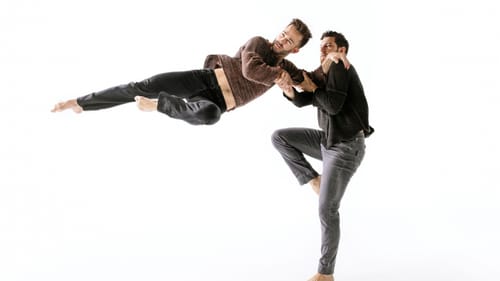Stay in the Loop
BSR publishes on a weekly schedule, with an email newsletter every Wednesday and Thursday morning. There’s no paywall, and subscribing is always free.
The meaning of the moon
Swarthmore College presents Doug Varone and Dancers in residency

Style. What is it? Who has it? Most people recognize it when they see it. But what are its signifiers, identifiers, and meanings? Is style organic, or is it deliberate and crafted over time? Can anyone achieve style? What does style mean in dance? Is it something about the dancer or choreography or a company, like Cunningham or Bausch? These questions raced through my mind as I watched Doug Varone and Dancers last weekend at Swarthmore College’s LPAC Pearson-Hall Theatre, in residency all week, working with Swarthmore dance department students.
Twenty years of Varone
Over two decades, this is the sixth time I’ve seen and written about the company and its ever-changing members. Its works evolve to accommodate those new dancers’ individuality. Somehow, they also accommodate Varone’s open-breasted and inimitable style. Watching his wholehearted armspread, you almost anticipate an embrace.
Dancers Hollis Bartlett, Jake Bone, Bradley Beakes, Whitney Dufrene, Aya Wilson, and Ryan Yamauchi were all fairly new to my eye when I saw them in 2017 at Annenberg. As core members today, they embody that Varone style while preserving their own personalities.
Striving for a style
“in the shelter of the fold” opened the evening. In “folded,” the show-stopping second section set to composer Julia Wolfe’s breakneck ‘Believing,” Bartlett and Beakes pulsed with pushes and pulls, lifts and drops, and skips and hops that often had a contact-improv look. Stillnesses contrasted with blurred dancing, and intimate touching avoided eye contact. Yet the two remained meaningfully connected, holding hands and shaking their heads, violently. No, they are saying. To each other? To temptation?
I held my breath once Varone set foot on stage in “field,” his duet with Courtney Barth. His release-based movements and spiritual mien expressed vulnerability, a thoughtfulness. It fit well with Michael Gordon’s (Wolfe’s husband) introspective music, titled “Light Is Calling.” When Varone faltered near the end, Barth quickly came to his aid, and he seemed grateful to her.
“Not all modern choreographers strive for a style,” Varone once told me. “I do.” Unlike ballet, where the port de bras is in the curve and control of the upper torso, shoulder, and arms, Varone releases them so they look out of control and free to propel his dancers wherever he envisions them in the space. It’s a recognizable characteristic.

The meaning of the moon
The penultimate section, “mass,” generously gave the students each a moment in the spotlight and folded them in dramatically. They followed Yamauchi, fell prostrate behind him, and then crawled toward him as he stood, his back turned to them indifferently. Varone’s canny connection to David Lang and his Bang on a Can Allstars composers shaped the sections into a whole. Of its six parts, I found “folded” and “field” most stirring.
Philip Glass’s “The Light,” commissioned in 1987 and structured on the 1887 Michelson-Morley investigation of the speed of light, provided the essential intellectual motive for the choreography of Varone’s 2006 “Lux.” A full moon rose in a straight line behind the dancers from the bottom of the stage up to the flys. I wondered why—ordinarily, you would see the moon move across the sky in an arc. A little research turned up that the 1887 experiment compared the speed of light in perpendicular directions, so contrary to some reviews, the moon and its vertical ascent were extremely relevant to this dance.
Meeting meteoric notes
Watching Bartlett’s vertical performance in the opening and closing solos in this iteration of the work gave me a fuller insight into it. His negative head shaking at the end of each solo must have been a nod to the fact that though the experiment famously failed, it may yet have contributed to Einstein’s Theory of Relativity. I am positively dizzy with delight to be looking at “Lux” with all this information. The dancers flitted among Glass’s meteoric notes like fireflies in the dark, lit mid-torso by Robert Wierzel’s fine lighting. Juddering feet in backwards thrusts often captured the notes headlong, yet left space for emotional harmony.
Dancers entered individually and formed semi-circles, airplane-ing off in leaping spins. Their elbows thrust them back in reverse runs. Joyfully, they threw limbs and necks back with abandon, even tapdancing a bit and smiling, making eye contact. Bartlett, head and shoulders flung back, stretched his arms up and outwards. Was he conducting the score? Or reaching for the moon?
What, When, Where
A performance by Doug Varone and Dancers in residency at Swarthmore College. Choreography by Doug Varone. November 15, 2019 at Lang Performing Arts Center Pearson-Hall Theatre, 500 College Avenue, Swarthmore, PA. (610) 328-8000 or swarthmore.edu/cooper-series/doug-varone-and-dancers-residency.
Sign up for our newsletter
All of the week's new articles, all in one place. Sign up for the free weekly BSR newsletters, and don't miss a conversation.

 Merilyn Jackson
Merilyn Jackson